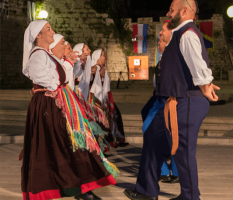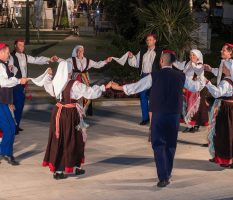- Home
- Rab dance
Rab dance
THE RAPSKI TANAC FOLKLORE SOCIETY
The Rapski Tanac (Rab Dance) Folklore Society has been active since 1987 and, throughout this period, it has greatly contributed to the promotion of Rab tourism, representing a segment of the cultural heritage of the island of Rab.
In addition to regular performances held on Rab, the company has participated in several traditional festivals: in Metković, at Vinkovci Autumns, in Nova Gradiška, in Zagreb, and abroad – in Germany, Luxembourg, Hungary, Austria and Slovenia.
The members of the folklore society perform the original local dance (tanac) and sing traditional local songs (kantanje) of the island of Rab, wearing two types of costumes: a more recent type and the traditional costumes that are over a hundred years old. The Rab tanac dance has its own rather fixed structure and is accompanied by mih bagpipes.
Repertoire:
1. A traditional dance performed in the original traditional costumes over a hundred years old – 8 min
2. A combination of figures of the Rab dance performed in a more recent type of costumes – 8 min
In 2012, the old custom of proposing to the bride was once again restored – the arrival of the groom accompanied by the best man and the stari svat (the wedding party elder) to the bride's house – called Svatovsko (the Wedding Party).
In addition to the traditional folk songs and dances of the island of Rab, this folklore society performs songs and dances from other parts of Croatia as well.
Thus, they have currently expanded their repertoire with six more choreographies:
Old Dances of Split, choreographed by Branko Šegović
The characteristics of this dance are elegance and soft dance movements, with visible influences of Western Europe and the Mediterranean.
Old Dances of the Island of Korčula, choreographed by Branko Šegović
These dances are also characterised by elegance, grace and the lightness of steps, as well as the lovely smiles and seduction of partners.
The Bunjevac Fairy, choreographed by: Jasna Dumičić, arranged by: Nikola Tuškan
The Bunjevci dances are characterised by pride, rhythm and liveliness, with slightly pronounced vertical movements. While the male dancers, accompanied by the sound of rattles, perform steps of almost a virtuoso quality, the female dancers dance in tiny, restrained and elegant steps.
The people from Bunjevci are also known for their rich and lavish costumes.
Each to Her Own – dances from the island of Korčula, choreographed by Jasna Dumičić
This dance is performed in couples. Male partners periodically exchange their female partners during the dance, but the female partner always returns to her original parner; hence the origin of the name. This dance is characterised by the dancers’ specific hold. They dance facing each other, with the male dancer clasping the female dancer around the waist with his right hand, trying to bring her closer to him, but she holds her left hand to his chest, controlling how close he can get to her. The dance is danced elegantly and gracefully, but, at the same time, firmly, with a pronounced vertical movement.
I’d Like to Get Married Now Too – Ražavac circle dance, choreographed by Jasna Dumičić
The Ražanac dance is a silent circle dance, in which the dancers use their steps to beat out the rhythm, gradually accelerating it. It is special and unique for shuffling and stamping the feet on the ground, while shouting Opa! Although the dance is originally danced by both men and women, this choreography is a version with girls only, depicting a segment from history – the girl has joined the circle to prove that she is old enough for it, i.e., for the young man. At the same time, the young men look at the girls who are sturdier and stronger, and who stamp their feet harder because they are the ones who will be more suited to working in the vineyard and field and who will bear children more easily. Despite the strong stamping of the feet, elegance and a sense of rhythm are also important.
Dance, Dance, Outdance the Bride – a skipping and jumping dance from the Dubrovnik littoral, choreographed by Jasna Dumičić
This dance represents one of the most famous dances of the Dubrovnik littoral. It is danced to the accompaniment of the lijerica string instrument, and the dancers dance in couples around the lijerica player. Different figures are alternated in both directions, with their order determined by the dance leader, who shouts out (sometimes ambiguous) commands how to dance. The couples have a specific hold: with their elbows held high, the male dancer holds the female dancer's right hand with his right one, and her left hand with his left one. The palms of the woman’s hand are turned inwards and the palms of the man’s hand are turned outwards. In the past, this dance was danced to the accompaniment of the mih bagpipes.
The society has also started a tamburica lute section, which is necessary as accompaniment to the choreographies. The section is still in the rehearsing stage.
The youth group of the Rapski Tanac Folklore Society has been active since 2005. In addition to performing on the island of Rab, they have also participated in several traditional festivals: in Metković, at Vinkovci Autumns, in Rogaška Slatina, and in Kutina, where, in 2009, they competed at the 7th Children's Folklore Festival of Croatia and won the first place – gold medal in the 10 to 14 years category.













